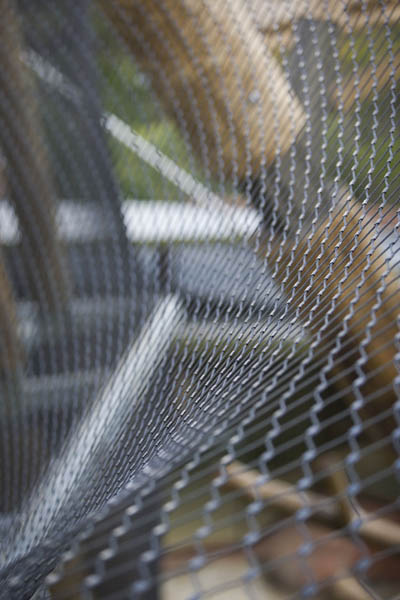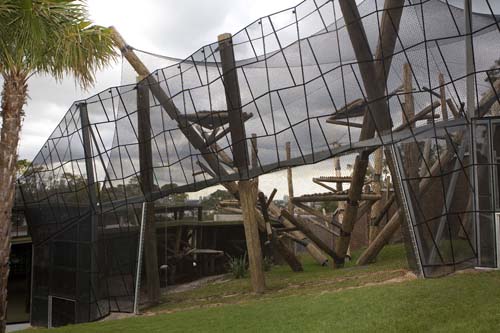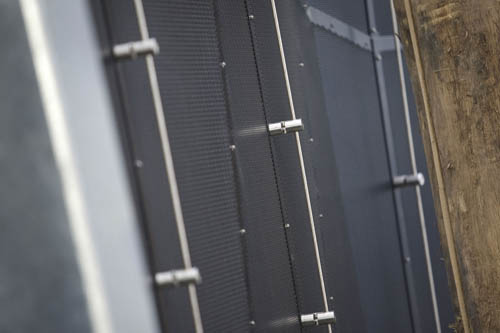
Where Strength Meets Style
Innovation in zoo enclosure design is a key feature of the recently completed $7.5 million makeover of the Chimpanzee Sanctuary at Sydney’s Taronga Zoo.
The project brief was to create a chimpanzee habitat akin to their native home that would encourage social interaction and allow the zoo’s primate keepers to manage animal husbandry and the group’s changing demographic. The enclosure’s transparency and the ability to withstand the chimpanzee’s remarkable strength and intelligence were essential.
ASSDA member Ronstan Tensile Architecture was contracted by the builder, the Lipman Group, to be the specialist contractor for the technical design and installation of a mesh enclosure and non-climbable wall. Ronstan’s unique capability in tensile architecture and their technical expertise were a natural fit for this challenging project designed by Jackson Teece Architects.
 The Sanctuary features the mesh separation paddock (similar to an aviary), at one end of the main exhibit. A non-climbable wall with a removable curtain, allows both spaces to function as one large paddock. This enables introductions of new chimpanzees into the compound and helps manage the apes’ complex behaviour patterns.
The Sanctuary features the mesh separation paddock (similar to an aviary), at one end of the main exhibit. A non-climbable wall with a removable curtain, allows both spaces to function as one large paddock. This enables introductions of new chimpanzees into the compound and helps manage the apes’ complex behaviour patterns.
Ronstan Tensile Architecture’s General Manager, Rowan Murray, said the non-climbable wall structure was one of the most the challenging design aspects.
“The architect’s greatest challenge was to separate the chimpanzees physically, but still have them all in view in the paddock. We had to build a wall that was transparent, had openings of no more than 5mm to avoid chimpanzees putting their fingers in and climbing, and could withstand the strength of chimpanzees.” Mr Murray said.
The structural complexity of the non-climbable wall required 3D modelling to analyse design configurations and ensure structural integrity. Test panels of the non-climbable wall were fabricated and assessed in the chimpanzees’ temporary enclosure to determine which would offer the safest containment of the site and minimise visibility.
Mr Murray said the primary structure for the wall consists of a Ronstan supplied tensile cable net that supports semi-transparent perforated stainless steel panels.
“Most materials can be damaged, but the durability of stainless steel panels of certain perforation proved to be the right solution and important in the development of the overall design,” he said.
 “The non-climbable wall had been designed with wall panels clamped directly to the enclosure mesh face. In a collaborative effort, we changed this to an independent cable net structure to remove the risk of having the final wall shape differ from that modelled, and in doing so, avoided the risk of panel geometry differing from the complex 10 degree incline necessary for non-climbability. This also ensured uniform set out and fixing methods, more consistent panel shapes and allowed the panel geometry to drive the wall structure rather than this being determined by other elements.”
“The non-climbable wall had been designed with wall panels clamped directly to the enclosure mesh face. In a collaborative effort, we changed this to an independent cable net structure to remove the risk of having the final wall shape differ from that modelled, and in doing so, avoided the risk of panel geometry differing from the complex 10 degree incline necessary for non-climbability. This also ensured uniform set out and fixing methods, more consistent panel shapes and allowed the panel geometry to drive the wall structure rather than this being determined by other elements.”
ASSDA member, Locker Group, supplied the grade 304 stainless steel panels, which were perforated to 50%. A black painted finish was applied before installation.
With stringent performance characteristics to adhere to, including long-term corrosion resistance and aesthetics, Carl Stahl X-Tend stainless steel mesh was specified for the separation enclosure and the removable curtain within the non-climbable wall. The stainless steel mesh was blackened using an electrolytic process to increase transparency of the enclosure.
Trevor Williams, Lead Consultant of Jackson Teece and Project Architect for the development, said materials selection was critical in delivering the aesthetic appeal and longevity of the enclosure.
“We spoke with Ronstan Tensile Architecture for technical design advice in the early stages of the project. There were various other types of meshes that were a possibility but, being a dynamic structure, alternate materials were far too rigid and not as flexible as the Carl Stahl X-Tend stainless steel mesh. I don’t think we could have achieved this outcome with any other mesh,” Mr Williams said.
“The stainless steel will have a longer life in the aggressive south-facing coastal environment. The blackened mesh has a fantastic form and from an architectural point of view, has achieved an organic appearance.”
from an architectural point of view, has achieved an organic appearance.”
Ronstan Tensile Architecture’s contribution to the project, including the tensile mesh enclosure and non-climbable wall, cost about $1.2 million and took 16 weeks to construct.
Mr Murray said the stainless steel demonstrates a great mix of strength and transparency, and the end tensile result is very forgiving.
“Achieving the architectural intent involved complex modelling and finite analysis of the mesh form to ensure the surrounding structures could be designed to support the enclosure loads. Ronstan is absolutely rapt with the state-of-the-art structure,” he said.
The paddock was completely re-landscaped and the impressive exhibit also now features several climbing platforms at varying heights of up to 12 metres, and a 180 kilogram hammock for the chimpanzees to enjoy.
The 17 lucky Taronga Zoo chimpanzees moved in to their renovated home in late September 2011.
QUANTITIES AND GRADES OF STAINLESS STEEL USED
› Mesh enclosure 770m² of 3mm Ø x 60mm blackened stainless steel, grade 316 Carl Stahl X-Tend mesh.
› Non-climbable wall facade 140m² of grade 304 stainless steel perforated to 50%, with a black painted finish.
› Cables 1x19 construction 8mm, 12mm and 22mm diameter, grade 316 stainless steel cables. The stainless steel cable end fittings and components were polished and passivated prior to installation.
Images courtesy of Ronstan Tensile Architecture.
This article features in Australian Stainless magazine - Issue 50, Summer 2011/12.